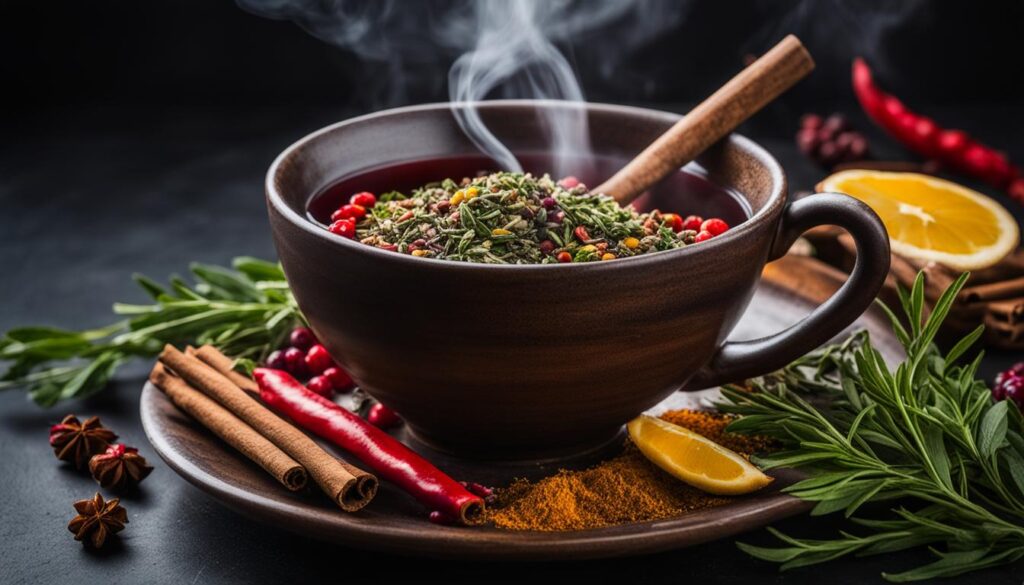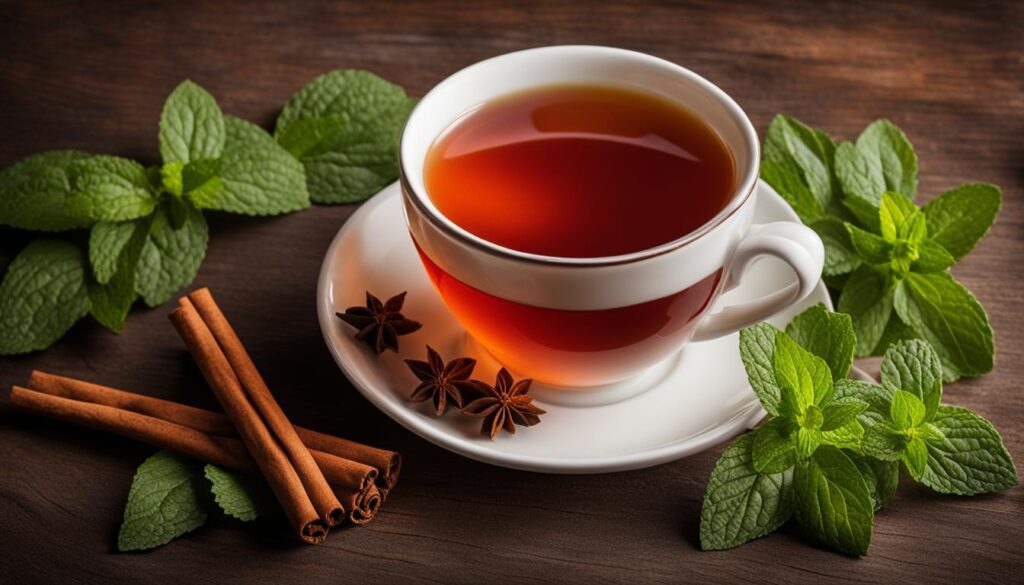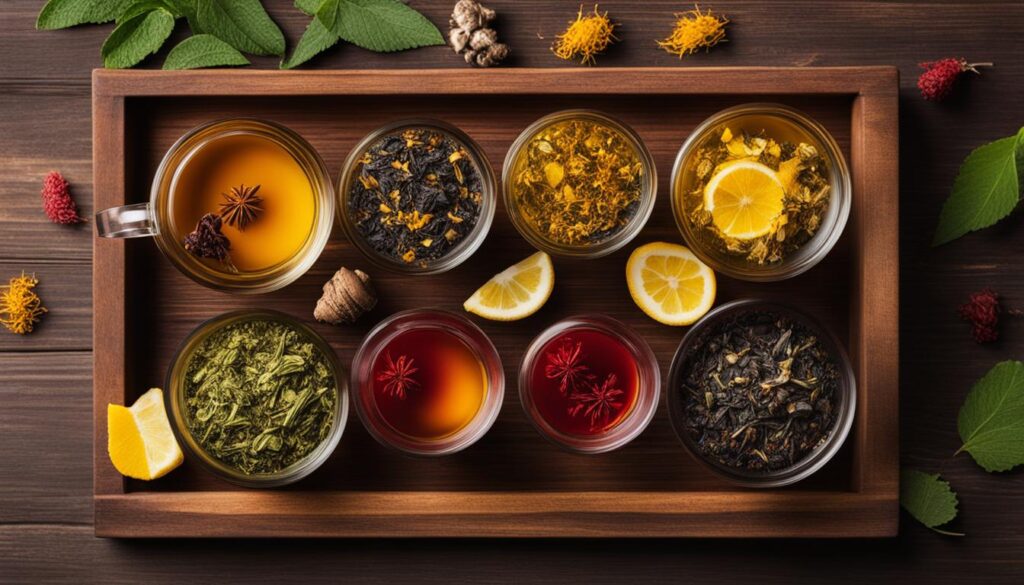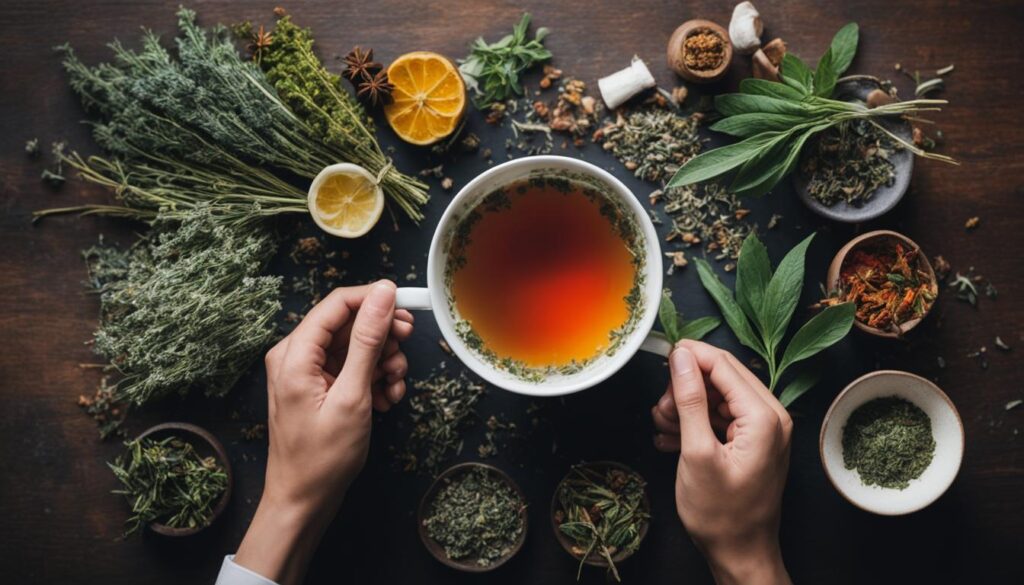Good blood flow is essential to ensure that our cells receive the necessary oxygen and nutrients. Taking care of our circulation is important for overall health and can be especially beneficial for athletes and exercise enthusiasts. Poor circulation can lead to various symptoms such as tingling, numbness, cramps, swelling, and pale or blue-tinged skin. It is important to address the underlying causes of poor circulation and seek medical attention if needed. There are several ways to improve blood circulation, including regular cardio workouts, quitting smoking, staying hydrated, and maintaining a healthy diet. Herbal tea can also play a role in boosting blood circulation by providing warmth, hydration, and certain ingredients that promote blood flow, such as green tea, cinnamon, garlic, turmeric, and hawthorn.
Key Takeaways:
- Good blood flow is vital for overall health and can benefit athletes and exercise enthusiasts
- Poor circulation can cause various symptoms and should be addressed
- Ways to improve blood circulation include exercise, quitting smoking, staying hydrated, and maintaining a healthy diet
- Herbal tea can contribute to blood circulation by providing warmth, hydration, and circulation-boosting ingredients
- Green tea, cinnamon, garlic, turmeric, and hawthorn are examples of ingredients that promote blood flow
The Importance of Circulation for Overall Health
Our circulatory system plays a crucial role in delivering oxygen and nutrients to our body’s cells, as well as removing waste products. Good blood circulation is essential for maintaining the proper functioning of our organs and tissues, supporting overall health and well-being.
For athletes and exercise enthusiasts, circulation is particularly important as it directly impacts performance and recovery. Efficient blood flow ensures that muscles receive an adequate supply of oxygen and nutrients during physical activity, enhancing endurance and maximizing energy levels.
On the other hand, poor circulation can have negative effects on our health. It can lead to various symptoms including tingling, numbness, cramps, swelling, and pale or blue-tinged skin. In severe cases, it can contribute to more serious conditions such as peripheral artery disease or even increase the risk of heart disease and stroke.
Recognizing the signs of poor circulation is vital for early intervention. If you experience any of the aforementioned symptoms or notice persistent issues related to blood flow, it is crucial to seek medical attention to identify and address the underlying causes of poor circulation.
By prioritizing good blood flow, we can support the optimal functioning of our body and enjoy the following benefits:
- Improved oxygen and nutrient delivery to cells
- Enhanced energy levels and performance
- Promoted healing and recovery
- Reduced risk of cardiovascular diseases
- Healthy skin tone and appearance
To visualize the impact of good blood flow, consider this analogy: think of circulation as a well-maintained highway system that ensures traffic flows smoothly, reaching their destination efficiently. On the other hand, poor circulation can be likened to congested roads with traffic jams and delays, impeding the delivery of goods and services.
It is clear that blood circulation is a crucial aspect of our overall health. It affects every part of our body, from our brain to our toes. Prioritizing circulation through lifestyle choices and seeking medical attention when necessary can help optimize our well-being and quality of life.
Causes of Poor Circulation and When to Seek Medical Attention
Poor circulation can have various causes, including:
- Peripheral Arterial Disease (PAD): PAD is a condition where the arteries in the legs narrow, restricting blood flow to the lower extremities. This can result in symptoms such as pain, cramping, and weakness.
- Diabetes: Diabetes can cause damage to blood vessels and nerves, leading to poor circulation. It is important for individuals with diabetes to manage their blood sugar levels and seek medical attention if they experience signs of poor circulation.
- Varicose Veins: Varicose veins are enlarged and twisted veins that can disrupt blood flow and contribute to poor circulation. These veins often appear swollen and can cause discomfort or pain.
- Blood Clots: Blood clots can block or restrict blood flow, leading to poor circulation. If you experience sudden swelling, pain, or discoloration in a leg or arm, it could be a sign of a blood clot and requires immediate medical attention.
- Raynaud’s Disease: Raynaud’s disease is a condition that affects the arteries in the fingers and toes, causing them to narrow in response to cold temperatures or stress. This can result in decreased blood flow and symptoms like numbness, tingling, and color changes in the affected areas.
If you experience signs of poor circulation such as tingling, numbness, cramps, swelling, and pale or blue-tinged skin, it is important to see a doctor. They can determine the underlying cause of the poor circulation and recommend appropriate treatment.
Natural Remedies for Improved Blood Circulation
In addition to medical treatments, there are several natural remedies that can help improve blood circulation. Incorporating these remedies into your daily routine can support healthy circulation and contribute to overall wellness. Here are some lifestyle changes and natural remedies to consider:
Exercise for Circulation
Regular exercise, especially cardiovascular workouts, can significantly boost blood circulation. Engaging in activities such as brisk walking, running, swimming, or cycling helps strengthen the heart and improves the efficiency of the circulatory system. Aim for at least 30 minutes of moderate-intensity exercise most days of the week.
Hydration for Circulation
Staying well-hydrated is important for maintaining healthy blood circulation. Good hydration keeps the blood volume at an optimal level and ensures that nutrients and oxygen are efficiently delivered to the body’s cells. Make sure to drink an adequate amount of water throughout the day, especially during physical activity.
Healthy Diet for Circulation
Adopting a healthy diet can have a positive impact on blood circulation. Include foods rich in fiber, omega-3 fats, and antioxidants to support cardiovascular health. Some examples of circulation-boosting foods are leafy greens, fatty fish, berries, nuts, and seeds. Avoid excessive consumption of saturated fats and processed foods, which can negatively affect circulation.
Herbal Remedies for Blood Circulation
Incorporating herbal remedies into your daily routine can provide additional support for blood circulation. Certain herbs have been traditionally used to improve circulation and promote cardiovascular health. Consider herbal teas containing ingredients like ginger, ginkgo biloba, cayenne pepper, and horse chestnut, which have properties that enhance blood flow and strengthen blood vessels.
You can also try incorporating other herbal supplements, such as garlic or turmeric capsules, under the guidance of a healthcare professional. It’s important to consult with a healthcare provider before starting any new herbal remedies to ensure they are safe and appropriate for your individual needs.
Finally, it’s worth mentioning that while natural remedies can be effective in improving blood circulation, they may not be sufficient for certain underlying medical conditions. If you experience persistent or severe symptoms of poor circulation, it’s essential to seek medical attention and guidance.

By making lifestyle changes, incorporating natural remedies, and seeking medical guidance when necessary, you can take proactive steps to improve your blood circulation and support your overall health.
How Herbal Tea Helps Blood Circulation
Herbal tea can be a powerful ally in boosting blood circulation and promoting overall well-being. Here’s how herbal tea contributes to the enhancement of blood flow:
- Warming Effect: When you sip on a cup of herbal tea, the warmth radiating from the beverage has a profound impact on your blood vessels. The heat causes the blood vessels to dilate, allowing for improved blood flow throughout the body.
- Hydration: Staying hydrated is essential for maintaining healthy blood volume, and herbal tea can contribute to your daily hydration needs. By incorporating herbal tea into your routine, you can ensure that you are supporting adequate blood circulation.
- Ingredients that Boost Blood Flow: Certain herbal tea ingredients have unique properties that directly affect blood circulation. Green tea, for example, contains catechins that act as powerful antioxidants and vasodilators, widening blood vessels and promoting improved blood flow. Cinnamon, garlic, turmeric, and hawthorn are also known for their circulation-boosting properties, making them excellent additions to herbal tea blends.
By enjoying herbal tea, you can harness the warming effect, promote hydration, and benefit from the circulation-boosting ingredients it contains. Incorporating herbal tea into your daily routine can be a soothing and delicious way to support healthy blood circulation.

| Herbal Tea Ingredient | Circulation-Boosting Properties |
|---|---|
| Green Tea | Contains catechins that act as antioxidants and vasodilators, promoting improved blood flow. |
| Cinnamon | Helps improve blood flow by reducing inflammation and dilating blood vessels. |
| Garlic | Has vasodilatory properties that can enhance blood circulation. |
| Turmeric | Helps improve blood flow by reducing inflammation and preventing platelet aggregation. |
| Hawthorn | Supports cardiovascular health and can enhance blood circulation. |
By incorporating herbal teas containing these circulation-boosting ingredients into your daily routine, you can support healthy blood flow and contribute to your overall well-being.
Choosing the Right Herbal Tea for Circulation
When it comes to supporting circulation, choosing the right herbal tea can make all the difference. Look for blends or products that contain ingredients known for their circulation-boosting properties. Incorporating these herbal teas into your daily routine can be an effective and enjoyable way to promote better blood flow throughout your body.
Here are a few popular options:
- Green Tea: Green tea is packed with antioxidants and bioactive compounds that have been shown to improve blood flow and lower blood pressure. It’s a refreshing choice that can provide a gentle boost to your circulation.
- Cinnamon: Cinnamon has been used for centuries for its warming properties and potential health benefits. It may help improve blood circulation by dilating blood vessels and increasing blood flow. Plus, it adds a delicious and comforting flavor to your herbal tea.
- Garlic: Garlic is known for its numerous health benefits, including its potential to promote better blood circulation. It contains compounds that help relax blood vessels and enhance blood flow. Incorporating garlic into an herbal tea blend can add a unique and flavorful twist.
- Turmeric: Turmeric contains an active compound called curcumin, which has powerful anti-inflammatory properties. It may help improve blood circulation by reducing inflammation and promoting healthy blood vessel function. Adding turmeric to your herbal tea can also give it a vibrant golden hue and a hint of earthy flavor.
- Hawthorn: Hawthorn is a herb that has long been used to support cardiovascular health and promote better blood circulation. It has been shown to improve blood vessel dilation, enhance blood flow, and support overall heart health. Including hawthorn in your herbal tea blend can provide additional benefits for circulation.
When choosing herbal tea products, it’s important to look for those made with high-quality herbs that are safe for consumption. You can find a variety of herbal tea blends specifically formulated to support cardiovascular health and blood circulation. These blends often combine several circulation-boosting ingredients to provide a comprehensive approach to improving blood flow.

Remember, herbal tea should complement a healthy lifestyle and shouldn’t replace medical treatments for serious circulation issues. If you have persistent symptoms or concerns about your circulation, it’s always best to consult with a healthcare professional.
By choosing the right herbal tea and incorporating it into your daily routine, you can enjoy the soothing benefits while supporting better blood circulation.
Incorporating Herbal Tea into Your Daily Routine
As part of a balanced routine for improved circulation, you can incorporate herbal tea into your daily routine. Daily herbal tea consumption can be a simple and enjoyable way to support your overall health and well-being. Whether you prefer a warm cup of herbal tea in the morning to kickstart your day, a soothing cup during a break to relax and unwind, or a calming cup in the evening before bed, there are many opportunities to enjoy this healthy beverage choice.

Herbal tea offers an array of flavors and varieties to suit different tastes and moods. By incorporating it into your daily routine, not only will you be hydrating your body, but you will also be reaping the potential circulation-boosting benefits that certain herbal tea ingredients offer.
“Herbal tea provides a refreshing way to stay hydrated while enjoying the additional benefits of herbal ingredients.” – Dr. Jennifer Thompson, Herbalist
As an alternative to sugary or caffeinated beverages, herbal tea provides a healthier choice. It is typically free of added sugars and artificial flavors, making it a great option for those looking to reduce their sugar intake. Additionally, herbal teas are naturally caffeine-free, making them suitable for individuals who are sensitive to or avoiding caffeine.
Incorporating herbal tea into your daily routine can be as simple as dedicating a few minutes each day to prepare and enjoy a cup. By making it a habit, you can experience the potential benefits of herbal tea on a consistent basis.
Ways to Incorporate Herbal Tea into Your Daily Routine
- Start your morning with a cup of herbal tea instead of coffee or sugary beverages.
- Enjoy a cup of herbal tea during a mid-morning or afternoon break to rehydrate and relax.
- Wind down in the evening with a cup of herbal tea to promote relaxation and prepare for a restful night’s sleep.
By prioritizing incorporating herbal tea into your daily routine, you can make it a part of your overall wellness practices. Remember to choose herbal teas that align with your taste preferences and contain ingredients known to support circulation for added health benefits.
| Herbal Tea Variety | Benefits |
|---|---|
| Green Tea | Promotes healthy blood flow and supports cardiovascular health. |
| Hawthorn Tea | Helps dilate blood vessels and improve circulation. |
| Ginger Tea | Boosts blood circulation and reduces inflammation. |
Remember, herbal tea should complement a well-rounded approach to circulation health, which includes regular exercise, a balanced diet, and maintaining a healthy lifestyle. It is always recommended to consult with a healthcare professional before making any significant changes to your diet or incorporating herbal remedies into your routine.
Final Thoughts on Herbal Tea for Circulation
After exploring the benefits of herbal tea for circulation and natural remedies for improved blood flow, it is clear that incorporating herbal tea into your daily routine can be a beneficial choice. Herbal tea provides warmth and hydration, which contribute to overall circulatory health. Moreover, certain ingredients found in herbal teas, such as green tea, cinnamon, garlic, turmeric, and hawthorn, have properties that promote healthy blood flow.
It is important to remember that while herbal tea can complement a holistic approach to improving circulation, it is crucial to seek medical attention for persistent symptoms of poor circulation. Consulting with a healthcare professional can help determine the underlying cause and provide appropriate treatment.
When choosing herbal teas, opt for blends or products that contain circulation-boosting ingredients. Selecting high-quality herbs and safe-to-consume products is key. Consider integrating specifically formulated herbal tea blends that support cardiovascular health and blood circulation into your daily routine.
In conclusion, herbal tea can be a valuable addition to a holistic approach to improve blood circulation. Enjoy the soothing benefits of herbal tea while providing hydration and potential circulatory benefits. Embrace the power of herbal tea as part of a balanced routine for improved circulatory health.
FAQ
Why is good blood flow important for overall health?
Good blood flow ensures that our cells receive the necessary oxygen and nutrients for proper functioning and removes waste products. It is essential for maintaining the health of our organs and tissues.
What are the signs of poor circulation?
Signs of poor circulation may include tingling, numbness, cramps, swelling, and pale or blue-tinged skin. These symptoms can vary depending on the underlying cause of the circulation issue.
What are the causes of poor circulation?
Poor circulation can be caused by conditions such as peripheral arterial disease (PAD), diabetes, varicose veins, blood clots, and Raynaud’s disease. It is important to see a doctor to determine the underlying cause and receive appropriate treatment.
When should I seek medical attention for poor circulation?
If you experience persistent symptoms of poor circulation, such as tingling, numbness, cramps, swelling, or changes in skin color, it is important to see a doctor. They can help diagnose the underlying cause and recommend appropriate treatment options.
How can I improve blood circulation naturally?
Natural remedies to improve blood circulation include regular exercise, staying hydrated, maintaining a healthy diet, and incorporating herbal teas into your daily routine. These lifestyle changes can support overall circulatory health.
How does herbal tea help improve blood circulation?
Herbal teas can help boost blood circulation by providing warmth, hydration, and certain ingredients that promote blood flow. Some herbal tea ingredients, such as green tea, cinnamon, garlic, turmeric, and hawthorn, have properties that directly affect blood circulation.
What herbal teas are best for circulation?
Herbal teas that are known for their circulation-boosting properties include those containing green tea, cinnamon, garlic, turmeric, and hawthorn. Look for herbal tea blends or products specifically formulated to support cardiovascular health and blood circulation.
How can I incorporate herbal tea into my daily routine?
You can enjoy a cup of herbal tea in the morning, during a break, or in the evening as a way to relax and unwind. Herbal tea can be a healthy alternative to sugary or caffeinated beverages, providing hydration and potential circulation-boosting benefits.
Is herbal tea a holistic approach to improving circulation?
Herbal tea can be a beneficial addition to a holistic approach to improving blood circulation. While it is important to seek medical attention for persistent symptoms of poor circulation, incorporating herbal teas into your daily routine can provide warmth, hydration, and certain ingredients that support healthy blood flow.